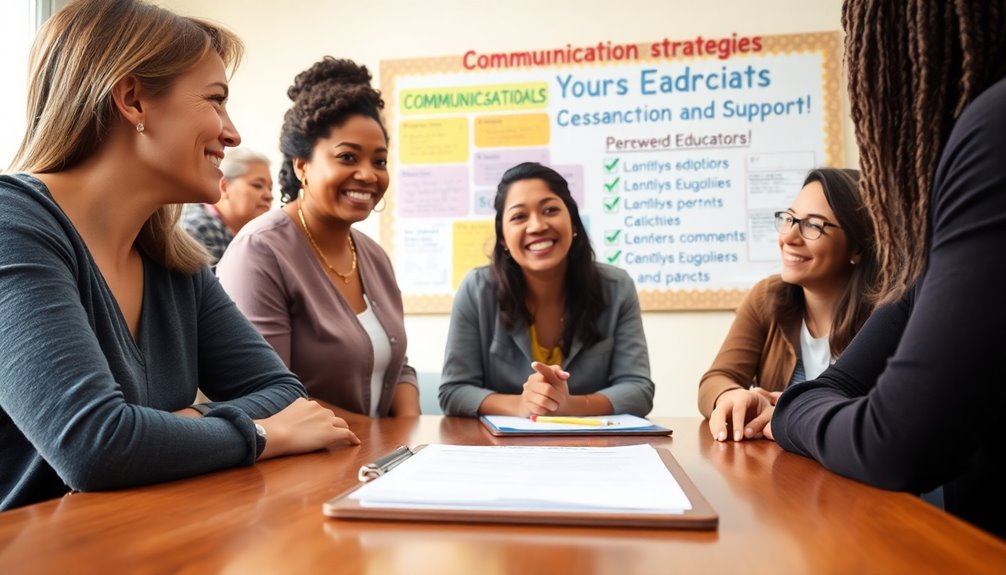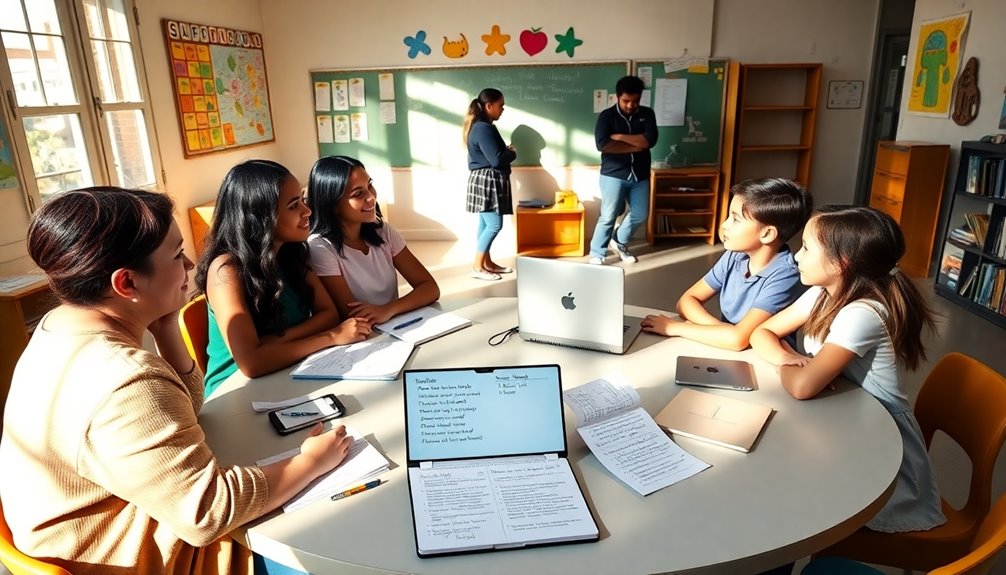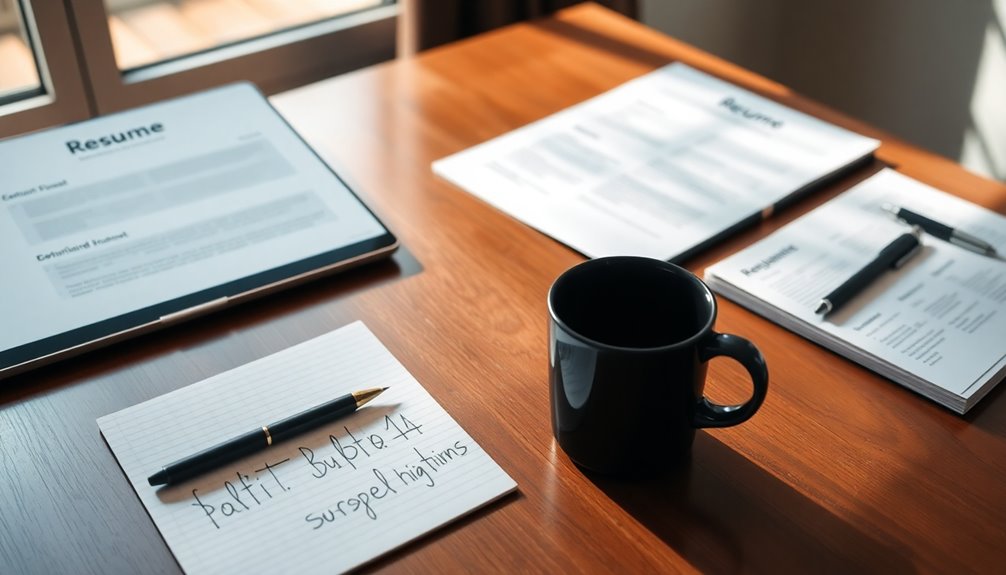To ace your paraprofessional interview, you should prepare for key questions that highlight your qualifications, behavioral management skills, and ability to communicate with parents. Anticipate inquiries like, "What techniques do you use for managing student behavior?" and "How do you support students with diverse learning needs?" Also, be ready to discuss your educational background and any relevant certifications. Demonstrating your understanding of special education principles and ethical practices is essential too. By focusing on these areas, you'll show that you're well-prepared. Discovering more interview strategies will further enhance your confidence for success.
Key Takeaways
- Prepare to discuss your educational background and how it aligns with the paraprofessional role, highlighting relevant coursework or certifications.
- Anticipate behavioral management scenario questions to demonstrate your ability to handle diverse learning needs effectively.
- Be ready to explain your communication strategies for engaging with parents and fostering collaboration in the educational process.
- Familiarize yourself with the district's special education programs to show your commitment and understanding of the students' needs.
- Reflect on your ethical practices and how you maintain confidentiality and professional boundaries while advocating for student rights.
General Interview Insights

When preparing for a paraprofessional interview, you'll want to be ready to discuss your interests, goals, and relevant skills. Expect questions like "Tell me about yourself" and "Why this district?" that help the interviewer gauge your fit.
Familiarize yourself with the special education programs offered by the district, as it shows your commitment and preparation. Be prepared to explain how your qualifications align with the role, highlighting personal strengths and areas for improvement.
Educational Background Requirements

A strong educational background is essential for a paraprofessional role, as it lays the foundation for effective support in the classroom. Typically, you'll need at least a high school diploma, but many districts prefer candidates with an associate degree or higher, particularly in education or a related field.
Coursework in child development, special education, or instructional strategies can markedly enhance your qualifications. If you're pursuing a teaching degree, it's critical to communicate your plans during the interview.
Additionally, any relevant certifications, such as CPR or first aid, should be mentioned. Being knowledgeable about special education programs is imperative, so be prepared to discuss how your education equips you to meet diverse student needs effectively.
Behavioral Management Skills

Effective behavioral management skills are essential for fostering a positive learning environment in the classroom. You need to establish clear expectations and routines that guide student behavior.
When disruptive behaviors arise, addressing them promptly and calmly is vital. Use positive reinforcement to encourage good behavior, and develop strategies tailored to individual students' needs.
You should also be able to distinguish between intentional and disability-driven behaviors, ensuring that your approach is appropriate and effective. Building rapport with students creates trust, making them more receptive to guidance.
Sharing examples of successful interventions during your interview can demonstrate your capability in this area. Highlight your ability to collaborate with teachers to create consistent behavior management strategies that benefit all students.
Parent Communication Strategies

Building strong communication with parents is vital for supporting student success in the classroom. By employing effective strategies, you can foster a positive relationship that enhances student learning. Here are some methods you might consider:
| Strategy | Benefits | Implementation Tips |
|---|---|---|
| Regular Updates | Keeps parents informed on progress | Use newsletters or emails |
| Scheduled Conferences | Builds rapport and addresses concerns | Set a consistent schedule |
| Open-door Policy | Encourages parent engagement | Make yourself approachable |
| Feedback Requests | Involves parents in the educational process | Ask for suggestions regularly |
| Clear Communication | Guarantees understanding and trust | Use simple language |
To further enhance engagement, consider discussing foster parent pay options available in your state, as this can help build trust and understanding with parents who may be navigating the complexities of the foster care system. These strategies can help you create a supportive environment where parents feel valued and involved in their child's education.
Public Interaction Guidelines

Maneuvering public interactions as a paraprofessional requires a blend of professionalism and approachability.
You'll often find yourself engaging with parents, students, and community members, so it's essential to handle these situations effectively.
Here are three key guidelines to keep in mind:
- Maintain Professionalism: Always represent your school positively, demonstrating respect and empathy in every interaction.
- Listen Actively: When addressing concerns, give your full attention. This shows you value their input and are committed to resolving issues.
- Set Boundaries: While being friendly and approachable, remember to maintain professional boundaries. This helps establish trust and respect in your relationships.
Supporting Diverse Learning Needs

Supporting diverse learning needs is essential for fostering an inclusive classroom environment where every student can thrive.
When you work as a paraprofessional, you'll encounter various learning styles and abilities. It's important to recognize each student's unique needs and adapt your approach accordingly.
Utilize differentiation strategies to tailor instruction, providing varied resources and activities that engage all learners. You'll also want to collaborate with teachers to guarantee that learning objectives are met for every student.
Regularly assess progress to identify areas for improvement and adjust your methods. Open communication with students, families, and educators fosters a supportive atmosphere. Additionally, incorporating mindfulness practices can help create a calm and focused learning environment.
Collaborating With Substitute Teachers

Often, collaborating with substitute teachers is essential for maintaining a seamless classroom environment. You can guarantee success by providing clear guidance and resources that help substitutes understand classroom expectations.
Here are three key strategies to evaluate:
- Prepare Detailed Lesson Plans: Create thorough lesson plans that outline daily activities, objectives, and any specific student needs. This clarity helps substitutes feel confident in their role.
- Establish Communication Channels: Maintain open lines of communication with substitutes before and after their assignments. This allows for questions and feedback, fostering a supportive atmosphere.
- Foster Relationships with Students: Encourage substitutes to build rapport with students. Positive interactions can enhance classroom dynamics and keep students engaged, even in the absence of their regular teacher.
Leadership and Classroom Management

Effective leadership in the classroom is essential for creating a positive learning environment where students thrive. You need to establish clear expectations and routines that promote engagement and minimize disruptions.
Building rapport with students is vital; when they feel valued, they're more likely to participate actively. You should use effective classroom management techniques, like consistent reinforcement of positive behaviors, to encourage a productive atmosphere.
When challenges arise, be prepared to address disruptive behaviors calmly and assertively, ensuring all students feel safe and respected.
Sharing your strategies for maintaining order and fostering respect can demonstrate your capability in handling classroom dynamics effectively, showcasing your leadership skills during the interview.
Differentiation Techniques

Creating a positive learning environment through leadership naturally leads to the need for differentiation techniques that cater to diverse learners.
You'll want to implement strategies that guarantee every student's needs are met. Here are three essential techniques to contemplate:
- Flexible Grouping: Rotate students through various groups based on their skills, interests, or learning styles, fostering collaboration and peer learning.
- Tiered Assignments: Design tasks at varying levels of difficulty, allowing students to work at their own pace while still addressing the same learning objectives.
- Choice Boards: Offer students options in how they demonstrate understanding, empowering them to engage with the material in ways that resonate with them.
These techniques can greatly enhance student engagement and learning outcomes.
Ethical Practices in Education

Ethical practices in education are vital for fostering an inclusive and respectful learning environment. You should prioritize confidentiality and maintain professional boundaries with students, families, and colleagues.
When faced with ethical dilemmas, reflect on your values and seek guidance from experienced professionals. Advocating for students' rights is essential; always guarantee their needs are met without bias.
You'll need to be aware of the ethical guidelines specific to special education, as they protect both students and staff. Regularly engage in conversations about ethics with your team to refine your understanding.
Frequently Asked Questions
What Motivates You to Work in Special Education?
What motivates you to work in special education is your passion for helping students overcome challenges.
You thrive on witnessing their growth and achievements, no matter how small. Building meaningful relationships with each student fuels your desire to create inclusive environments where everyone feels valued.
You're driven by the opportunity to make a positive impact on their lives and advocate for their needs, ensuring they receive the support necessary for success.
How Do You Handle Stress in the Classroom?
Did you know that 70% of teachers report feeling stressed during their first year?
To handle stress in the classroom, you've got to stay organized and prioritize self-care. When things get hectic, take a moment to breathe and refocus.
You can also establish clear routines for students, which helps create a calmer environment.
Building strong relationships with your students allows you to manage stress better, as you'll feel more connected and supported.
Describe Your Experience With Assistive Technology
When you think about your experience with assistive technology, focus on specific tools you've used, like communication devices or software that supports learning.
You've likely helped students engage more effectively through these technologies. Discuss how you've integrated them into lesson plans and the positive impact on student participation.
Share examples of how these tools have enhanced learning experiences and fostered independence among students with diverse needs in your classroom.
What Role Do You Believe Empathy Plays in Education?
When it comes to education, empathy's the name of the game. It fosters a supportive environment where students feel valued and understood.
When you show genuine care, you're more likely to connect with them on a deeper level, helping them thrive academically and emotionally.
Empathy also encourages open communication, making it easier to address challenges.
Ultimately, your ability to empathize can transform the classroom into a nurturing space where every student can succeed.
How Do You Stay Organized in a Busy Classroom Environment?
Staying organized in a busy classroom environment is essential. You can utilize tools like planners, checklists, and digital apps to keep track of tasks and schedules.
Prioritizing your responsibilities helps you focus on what's urgent. Establishing routines and designating specific areas for materials can streamline processes.
Regularly reviewing and adjusting your organization strategies guarantees you adapt to the classroom's needs, allowing you to maintain a productive, focused learning atmosphere.
Conclusion
To sum up, preparing for your paraprofessional interview isn't just about answering questions; it's about showcasing your genuine passion for education and student success. Did you know that candidates who share real-life experiences often make a lasting impression? By reflecting on your journey and articulating your strengths, you'll not only demonstrate your qualifications but also reveal your commitment to fostering inclusive environments. Embrace this opportunity to stand out and make a difference in the lives of students.
Eugene brings a fresh, dynamic voice to our platform as one of our talented Writers. Specializing in research-driven content, he explores the latest findings in psychology and personal growth, translating them into actionable insights for our readers. Eugene’s work is fueled by a curiosity about what makes us tick and a desire to help others unlock their potential.










